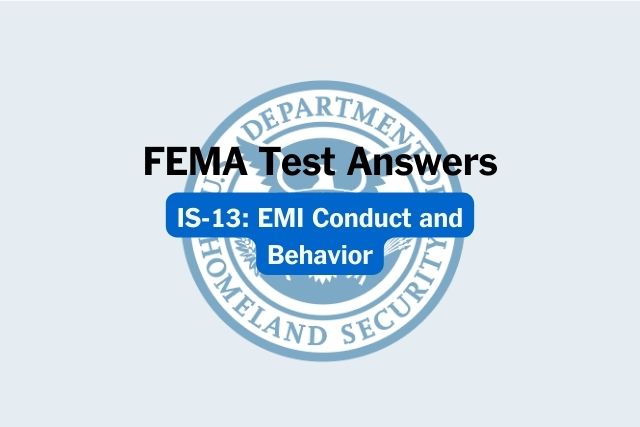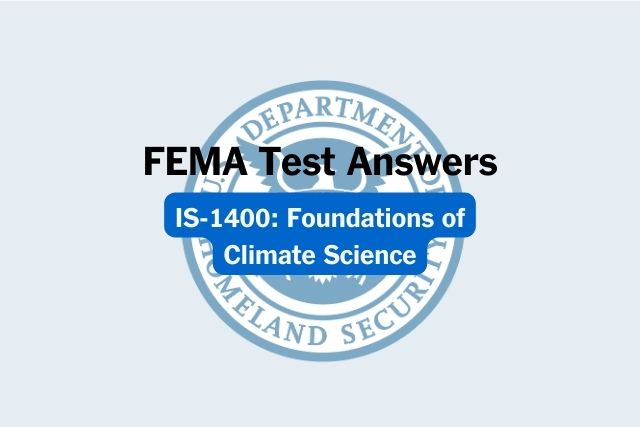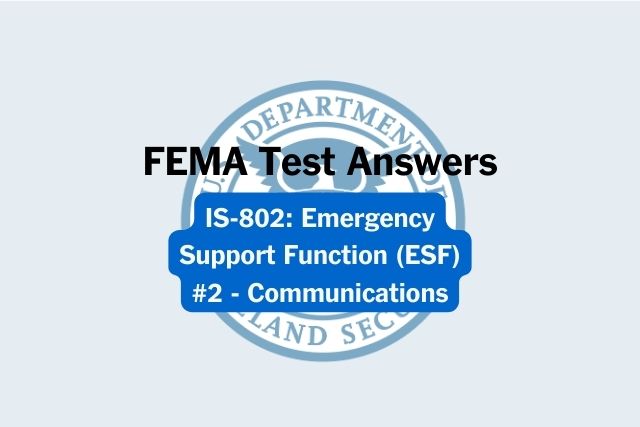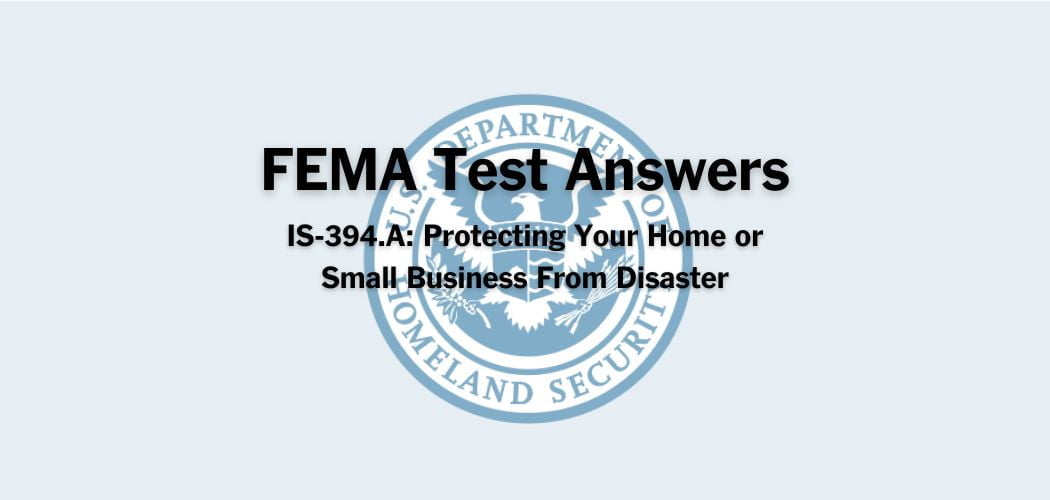Overview: The FEMA IS-2200 course was published on 5/17/2019 to introduce the role, design, and function of the Emergency Operations Center (EOC) and the supportive relationship as a NIMS Command and Coordination component of the Multiagency Coordination System.
At the completion of this course, you should be able to: identify considerations for deactivating the EOC within the context of Recovery; describe the role EOCs play in overall multiagency coordination.
FEMA IS-2200 test answers
Each time this test is loaded, you will receive a unique set of questions and answers. The test questions are scrambled to protect the integrity of the exam.
Question 1. If one of your EOC critical tasks is to execute contracts, your staff must _______ to execute a contract.
A. be able to demonstrate proficiency in all 17 EOC skillsets in order
B. have the authority✅
C. coordinate with the Liaison Officer
D. designate an Incident Command staff member
Question 2. Which of the following is an important consideration for deactivating an EOC?
A. When media and the public no longer pay attention to the incident
B. When the demand for resources and coordination exceeds staffing and resource levels
C. When the demand for resources and coordination slows down✅
D. When an incident increases in size, scope, and complexity
Question 3. How is the Incident Command System (ICS) interconnected with the other NIMS Command and Command and Coordination structures?
A. The ICS provides on-scene management of incidents and receives support from the EOC and MAC Group.✅
B. The ICS provides offsite support to on-scene EOC Operations and coordinates with the MAC group.
C. The ICS integrates incident information and Public Affairs across EOCs, MAC Group, and JIS.
D. The ICS provides offsite support to the EOC and MAC Group through policy guidance, high-level decision-making, and scarce resource allocation.
Question 4. Which of the following is NOT a key factor to consider when designing an effective EOC?
A. Likely threats and hazards the jurisdiction faces
B. EOC Organizational Structure
C. Community Lifelines✅
D. Communication
Question 5. The role of helping a community transition from response to recovery belongs to the ______.
A. Emergency Operations Center✅
B. Joint Information Center
C. MAC Group
D. Incident Commander
Question 6. What type of information is supported by the EOC?
A. Preliminary Damage Assessment data and Incident Action Planning Briefs.✅
B. Electronic versions of all records and emails with paper version backups.
C. Contingency plans for all likely scenarios.
D. Legal and financial records, such as contracts and property management records
Question 7. Which activation level is used when the entire EOC team is activated to support the response to a major incident?
A. Crisis Activation
B. Normal Operations/Steady State
C. Full Activation✅
D. Enhanced Steady-State/Partial Activation
Question 8. What type of information is supported by the EOC?
A. Operational Period Action Planning Brief.✅
B. Electronic versions of all records and emails with paper version backups.
C. Emergency operating records, such as SOPS, Delegations of Authority, and resource assignments
D. Contingency plans for all likely scenarios.
Question 9. What is the Recovery Continuum?
A. The Recovery Continuum is a Shared Situational Picture (SitPic) of the recovery operations.
B. The Recovery Continuum is a graphic that depicts the five mission areas of emergency management and how they intersect with the Recovery Support Functions.
C. The Recovery Continuum is a sequence of interdependent and overlapping activities that move a community toward recovery.✅
D. The Recovery Continuum is a monument in Washington, DC to honor the recovery efforts during recent disasters.
Question 10. Which activation level is used when certain EOC team members/organizations are activated to monitor a credible threat?
A. Emergency Activation
B. Normal Operations/Steady State
C. Full Activation
D. Enhanced Steady-State/Partial Activation✅
Question 11. Which EOC organizational structure separates the situational awareness function from planning?
A. Emergency Support Function Structure
B. Departmental EOC Structure
C. ICS or ICS-like EOC Structure
D. Incident Support Model (ISM) EOC Structure✅
Question 12. How is an EOC activated?
A. A jurisdiction will conduct a preliminary disaster assessment and provide it to the State for approval to activate the EOC.
B. A jurisdiction normally defines circumstances and processes for EOC activation in the policy.✅
C. The Resource Manager identifies the need for EOC activation and the Operations Section Chief stands up the EOC.
D. The Incident Commander typically tasks the Logistics Section Chief to activate and staff the EOC.
Question 13. An EOC must retain the ability to perform its function even with reduced staffing. One of the best ways of ensuring this happens is to ______.
A. provide transportation to and from the EOC for all staff.
B. cross-train all EOC staff.✅
C. ensure the EOC Director can perform all roles.
D. require that all staff must arrive and spend 24/7 on-site prior to any potential activation of the EOC.
Question 14. Emergency Operations Centers play a critical role in support of the on-scene response. They do this by ______
A. implementing appropriate operations portions of the Incident Action Plan.
B. supervising and configuring incident command Sections to maintain on-scene span of control.
C. collecting, analyzing, and sharing of information.✅
D. making tactical decisions at the incident scene.
Question 15. In a Normal Operations/Steady State EOC activation level, ______.
A. the EOC is staffed at the same level as Full Activation.
B. Routine watch and warning activities are conducted.✅
C. certain EOC team members/organizations are activated to monitor a credible threat, risk, or hazard and/or to support the response to a new and potentially evolving incident.
D. the EOC team is activated, including personnel from all assisting agencies, to support the response to a major incident or credible threat.
Question 16. Emergency Operations Centers coordinate with and support the ______, sometimes also called the policy group.
A. Decision Action Team (DCT)
B. Incident Management Team (IMT)
C. Multiagency Coordination (MAC) Group✅
D. Multi-coordination Assistance (MCA) Group
Question 17. When jurisdictions with differing policies are involved in a response, the EOC supports the ICS by providing:
A. High-level subject matter experts
B. Policy Direction✅
C. Tactics for the next operational period
D. Financial Support
Question 18. The role of the EOC in the Recovery Continuum is to ______.
A. assist the jurisdiction with the recovery efforts by deploying EOC staff to the field.
B. help transition a community from response towards recovery.✅
C. provide guidance on what agencies recovery work should be transitioned to when the EOC is deactivated.
D. mobilize Incident Management Teams to replace the EOC during recovery.
Question 19. What type of EOC staffing does this describe: ‘Most EOC staff members will be assigned responsibility for only one function or position’?
A. Staffing by capability
B. Preferred Staffing
C. Day-to-day staffing✅
D. Incident staffing
Question 20. What should EOC leadership consider when deactivating the EOC?
A. Mitigation planning requirements
B. Social media interest
C. Availability of staff
D. Recovery needs✅
Question 21. When staffing an Emergency Operations Center, which of the following is NOT a factor you should consider?
A. Identifying a highly qualified Incident Commander✅
B. Skills and abilities to perform critical tasks
C. Extended hours of operation
D. Tasks to be performed
Question 22. What is the role of situational awareness in EOC operations?
A. The MAC Group provides situational awareness to the EOC so the EOC staff can make better policy decisions for the incident.
B. The EOC uses situational awareness to develop a Situational Picture (SitPic) that is shared between ICS, EOC, MAC Group, and JIS participants in the incident.✅
C. Incident Command provides situational awareness to the EOC so the EOC can develop the Incident Action Plan.
D. Situational awareness has no role in EOC operations, it is used by Incident Command to maintain awareness of incident risks.
Question 23. When selecting an EOC or alternate EOC, designing a floor plan for the EOC, or evaluating EOC operations, what key factors should you consider?
A. Equipment requirements established EOC authorities and procedures, and staffing requirements✅
B. Access to technology support, size of the space, and convenience
C. Meeting NIMS mandates, finding a location near the incident scene, and community lifelines
D. Affordability, proximity to restaurants, and backup systems
Question 24. Which NIMS communication principle helps ensure the uninterrupted information flow?
A. Security
B. Resilience and Redundancy✅
C. Interoperability
D. Reliability, Scalability, and Portability
Question 25. The level of activity within an EOC often ______ as the size, scope, and complexity of the incident grow.
A. varies
B. remains the same
C. increases✅
D. decreases



